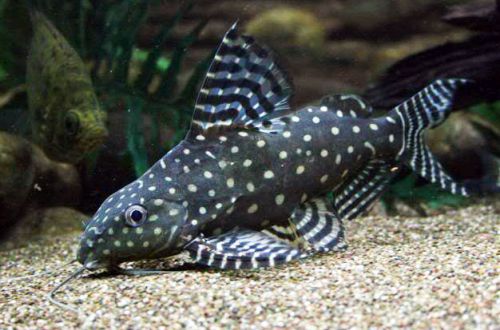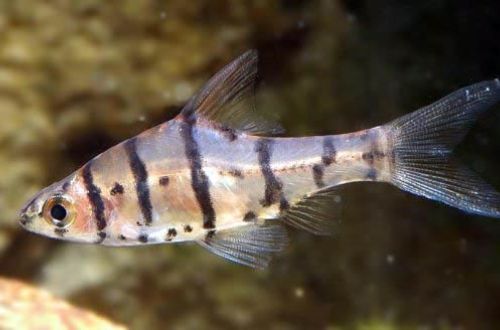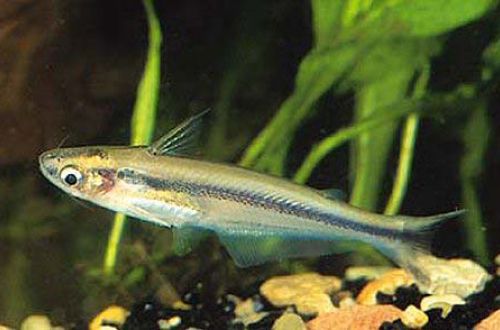
Kardinal
Cardinal, scientific name Tanichthys albonubes, belongs to the Cyprinidae family. The most popular aquarium fish, easy to keep and breed. As of 2010, there are four well-established breeding color forms, but only two of them are most widely used – close to natural color and with a predominance of red.
Nilalaman
Tahanan
The homeland of the species is the territory of modern China. Currently, fish are practically not found in the wild and are on the verge of extinction, listed in the Red Book. Several relict populations have been found in the coastal province of Guangdong (southern China) and in the province of Quang Ninh, northeast Vietnam. They live in slow-flowing rivers and streams, prefer to stay at shallow depths up to 60 cm near dense coastal aquatic vegetation.
Maikling impormasyon:
- Ang dami ng aquarium - mula sa 60 litro.
- Temperatura – 14-22°C
- Halaga ng pH - 6.0-8.5
- Water hardness – soft to hard (5-21dGH)
- Uri ng substrate - anumang
- Pag-iilaw – nasusupil
- Maalat na tubig – hindi
- Paggalaw ng tubig – mahinang agos o tahimik na tubig
- Ang laki ng isda ay hanggang 4 cm.
- Pagkain – anumang pagkain
- Temperament – mapayapang kalmado na isda
- Pagpapanatili sa isang kawan ng 10 indibidwal
paglalarawan
Adults reach a length of 4 cm. Females are somewhat larger than males, but less colorful. There are several color forms. One is closer to natural coloration, the dominant color is gray with a wide bright pink stripe stretching from head to tail. The wide fins have a pale yellow edging. Another form has a similar color, but with a pronounced red pigment, which is painted on the back of the body, tail and edges of the fins.
Pagkain
They accept all types of dry, frozen and live food. A combination of different species is the most preferred option, in this case the fish show their best color. Feed 2-3 times a day in the amount eaten in 5 minutes, remove leftovers in a timely manner to prevent water pollution.
Pagpapanatili at pangangalaga, pag-aayos ng aquarium
The recommended volume of the tank for one flock of fish starts from 60 liters. The design is arbitrary, however, a combination of a dark substrate and a certain amount of floating plants is considered the best option. Artificial or natural snags, roots and / or branches of trees are used as decor.
The standard set of equipment consists of filtration and lighting systems, an aerator. The cardinal prefers relatively low temperatures, so there is no need for a heater if the aquarium is set up in a living area.
Water conditions are characterized by a weak internal flow, temperature, pH and dGH parameters are in a wide acceptable range of values, so the preparation of water is not associated with great difficulties, in most cases it is enough to defend it during the day.
Ang pagpapanatili ng aquarium ay binubuo sa lingguhang pagpapalit ng bahagi ng tubig (20–25% ng volume) ng sariwang tubig, regular na paglilinis ng substrate mula sa mga organikong basura at pag-alis ng plaka mula sa salamin.
Pag-uugali at Pagkakatugma
Calm peace-loving fish, goes well with other species of similar size and temperament, able to live in similar temperature conditions. The content is flocking from 10 individuals of both sexes; within the group, males are forced to compete with each other for the attention of females, which contributes to an increase in the brightness of their color.
Pag-aanak / pag-aanak
Cardinal refers to spawning species, females scatter eggs in the water column, and males at this moment fertilize it. Parental instincts are poorly developed, immediately after spawning, the fish can eat their own caviar and fry that have appeared.
Inirerekomenda ang pag-aanak na isagawa sa isang hiwalay na tangke - isang pangingitlog na aquarium, upang maprotektahan ang mga supling mula sa mga pang-adultong isda. Ang disenyo ay simple, ang pangunahing pansin ay binabayaran sa lupa, dapat itong binubuo ng mga particle ng isang sapat na malaking sukat na hindi magkasya nang mahigpit sa bawat isa, na bumubuo ng mga voids, halimbawa, mga pebbles o pandekorasyon na mga kuwintas na salamin. Kapag ang mga itlog ay lumubog sa ilalim, karamihan sa mga ito ay nahuhulog sa mga puwang na ito at sa gayon ay hindi mapupuntahan ng mga isda. Ang isang katulad na epekto ay nakakamit din kapag gumagamit ng isang pinong mesh, na naayos sa ibaba.
Ang isa pang paraan upang matiyak ang pag-iingat ng mga itlog ay ang paggamit ng mga maliliit na dahon na halaman o lumot tulad ng Riccia floating at Javanese moss, na nakatanim sa halos lahat ng ibabaw ng substrate (sa kasong ito, ang lupa ay maaaring maging anuman) . Ang mga siksik na kasukalan ng mga halaman ay maaaring magbigay ng maaasahang kanlungan para sa mga itlog na hindi mas masahol kaysa sa espesyal na lupa.
Ang laki ng aquarium na pangingitlog ay karaniwang 20-30 litro, kalahating puno. Ang kagamitan na ginamit ay isang aerator, isang heater at isang simpleng sponge filter na may mababang kapangyarihan upang maiwasan ang aksidenteng pagsipsip ng mga itlog at prito. Ang pangingitlog ay nangyayari sa madilim na liwanag, kaya sa una ay hindi na kailangan ng liwanag na pinagmumulan.
The impetus for the beginning of the mating season is the establishment of a water temperature in the region of the upper permissible mark of 20–21 ° C at a neutral or slightly acidic pH value, as well as the inclusion of protein foods in the daily diet – bloodworms, daphnia, brine shrimp in live or frozen form.
After some time, the females become noticeably rounder, and the males will begin to actively show signs of attention to their chosen ones. At this point, you should prepare a separate tank and fill it with water from the general aquarium, then transplant several females and the most colorful males there. The easiest way to determine the end of spawning is by females, they will become slender.
Ibinalik ang mga isda. Ang prito ay lilitaw sa loob ng 48 - 60 na oras, at sa ibang araw ay magsisimula silang lumangoy nang malaya. Pakanin gamit ang espesyal na mikroskopikong pagkain para sa pagpapakain ng mga batang aquarium na isda.
Mga sakit sa isda
Due to long-term hybridization and inbreeding, undesirable consequences appeared in the form of weak immunity and a high proportion of congenital malformations among juveniles. A balanced diet and suitable living conditions reduce the risk of disease, but do not eliminate them. Read more about symptoms and treatments in the Aquarium Fish Diseases section.





